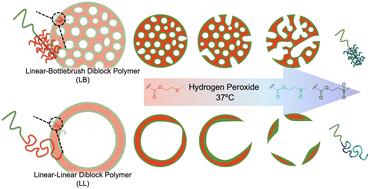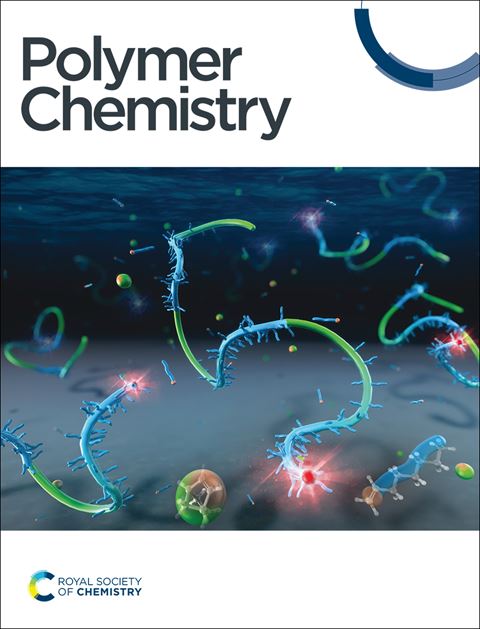硫醚基二嵌段共聚物的自组装:线性和瓶刷结构的比较研究
IF 3.9
2区 化学
Q2 POLYMER SCIENCE
引用次数: 0
摘要
两亲性二嵌段共聚物具有自组装成各种纳米结构的能力,可用于各种用途,因此被广泛研究。线性-线性二嵌段共聚物和线性-底部二嵌段共聚物因其分子结构的不同而表现出不同的自组装能力。在这项研究中,线性聚乙二醇(PEG)被用作亲溶性嵌段,而聚(2-(甲硫基)乙基甲基丙烯酸酯)(MTEMA,一种含硫醚的聚合物)被用作疏溶性嵌段,从而生成嵌段共聚物,其中 PMTEMA 也是线性嵌段(LL)或底丛嵌段(LB)。对这两种结构进行比较后发现,它们在水环境中的自组装存在差异。小角 X 射线散射(SAXS)和电子显微镜证实,LL 形成的囊泡尺寸分布较广,而 LB 产生的颗粒相对均匀,内部形态有序。聚合物颗粒还可以通过氧化剂进一步分解,从而可用于氧化触发的释放研究。本文章由计算机程序翻译,如有差异,请以英文原文为准。

Self-assembly of thioether-based diblock copolymers: a comparative study of linear and bottlebrush architectures†
Amphiphilic diblock copolymers are widely studied for their ability to self-assemble into diverse nanostructures for various applications. Linear-linear diblock copolymers and linear-bottlebrush diblock copolymers exhibit distinct self-assembly due to differences in their molecular architecture. In this study, linear poly(ethylene glycol) (PEG) was used as the solvophilic block, and poly(2-(methylthio)ethyl methacrylate) (MTEMA, a thioether-containing polymer), was used as the solvophobic block to generate block copolymers where PMTEMA was either also a linear (LL) or a bottlebrush (LB) block. Comparing both architectures revealed differences in their self-assembly in aqueous environments. LL formed vesicles with broad size distributions while LB produced relatively uniform particles with ordered internal morphology, as confirmed by small-angle X-ray scattering (SAXS) and electron microscopy. The polymer particles could further be disassembled through an oxidizing agent which in turn allowed them to be used for oxidation-triggered release studies.
求助全文
通过发布文献求助,成功后即可免费获取论文全文。
去求助
来源期刊

Polymer Chemistry
POLYMER SCIENCE-
CiteScore
8.60
自引率
8.70%
发文量
535
审稿时长
1.7 months
期刊介绍:
Polymer Chemistry welcomes submissions in all areas of polymer science that have a strong focus on macromolecular chemistry. Manuscripts may cover a broad range of fields, yet no direct application focus is required.
 求助内容:
求助内容: 应助结果提醒方式:
应助结果提醒方式:


